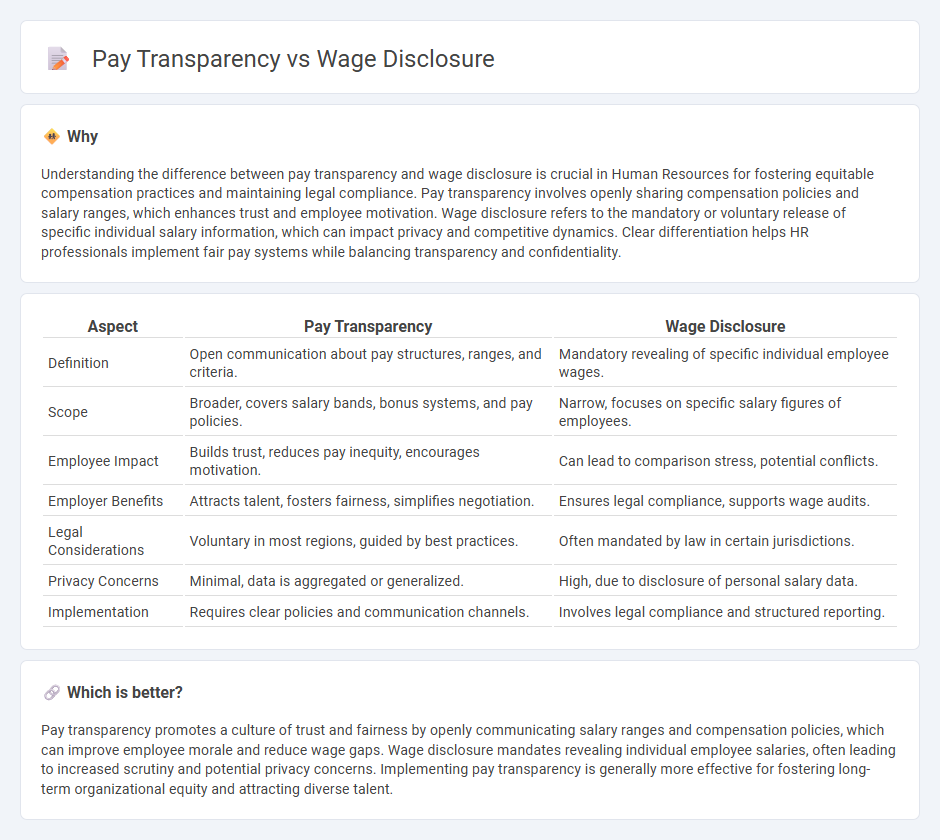
Pay transparency enhances employee trust and engagement by openly sharing salary structures within an organization, while wage disclosure typically involves revealing individual salaries under specific regulatory requirements. Transparent compensation practices support equitable pay, reduce wage gaps, and attract top talent by fostering a culture of fairness and accountability. Explore the nuances between pay transparency and wage disclosure to optimize your organization's compensation strategy.
Why it is important
Understanding the difference between pay transparency and wage disclosure is crucial in Human Resources for fostering equitable compensation practices and maintaining legal compliance. Pay transparency involves openly sharing compensation policies and salary ranges, which enhances trust and employee motivation. Wage disclosure refers to the mandatory or voluntary release of specific individual salary information, which can impact privacy and competitive dynamics. Clear differentiation helps HR professionals implement fair pay systems while balancing transparency and confidentiality.
Comparison Table
| Aspect | Pay Transparency | Wage Disclosure |
|---|---|---|
| Definition | Open communication about pay structures, ranges, and criteria. | Mandatory revealing of specific individual employee wages. |
| Scope | Broader, covers salary bands, bonus systems, and pay policies. | Narrow, focuses on specific salary figures of employees. |
| Employee Impact | Builds trust, reduces pay inequity, encourages motivation. | Can lead to comparison stress, potential conflicts. |
| Employer Benefits | Attracts talent, fosters fairness, simplifies negotiation. | Ensures legal compliance, supports wage audits. |
| Legal Considerations | Voluntary in most regions, guided by best practices. | Often mandated by law in certain jurisdictions. |
| Privacy Concerns | Minimal, data is aggregated or generalized. | High, due to disclosure of personal salary data. |
| Implementation | Requires clear policies and communication channels. | Involves legal compliance and structured reporting. |
Which is better?
Pay transparency promotes a culture of trust and fairness by openly communicating salary ranges and compensation policies, which can improve employee morale and reduce wage gaps. Wage disclosure mandates revealing individual employee salaries, often leading to increased scrutiny and potential privacy concerns. Implementing pay transparency is generally more effective for fostering long-term organizational equity and attracting diverse talent.
Connection
Pay transparency and wage disclosure both promote fairness and equity in Human Resources by openly sharing compensation information within organizations. These practices reduce wage gaps, improve employee trust, and enhance accountability in salary decisions. Implementing structured wage disclosure policies supports compliance with equal pay laws and fosters a culture of openness.
Key Terms
Salary Range
Wage disclosure involves legally mandating employers to share specific employee salary information, while pay transparency emphasizes openly communicating salary ranges within organizations to promote fairness and trust. Salary range transparency helps employees understand their earning potential and supports equitable pay practices across roles and departments. Discover more about how salary range disclosure can transform workplace equity and employee satisfaction.
Pay Equity
Wage disclosure mandates employers to share specific employee salary information, promoting accountability in pay equity by identifying unjustified wage gaps. Pay transparency encompasses a broader practice of openly communicating pay structures, salary ranges, and compensation criteria to foster trust and ensure fair remuneration across all organizational levels. Explore how implementing these strategies can drive measurable advancements in achieving pay equity within your workplace.
Compensation Policy
Wage disclosure involves legally mandated sharing of individual salary information, promoting accountability and addressing pay disparities, whereas pay transparency encompasses broader organizational openness about compensation structures, ranges, and criteria to foster trust and employee engagement. Compensation policy shapes these practices by defining the level of transparency, ensuring compliance with regulations, and aligning pay disclosure with organizational goals to enhance equity and motivation. Explore how tailored compensation policies can balance transparency with privacy to optimize workforce satisfaction and performance.
Source and External Links
Pay Transparency Laws By State - Provides an overview of pay transparency laws across different states and cities, including requirements for disclosing salary ranges in job postings.
The Salary Transparency Revolution - Discusses how new pay disclosure laws are changing the workplace by requiring employers to reveal compensation structures, helping to address wage gaps.
Pay Transparency: What It Is and Laws by State - Explains pay transparency, its benefits, and the various state laws requiring wage or wage range disclosure to candidates and employees.
 dowidth.com
dowidth.com